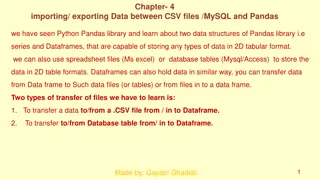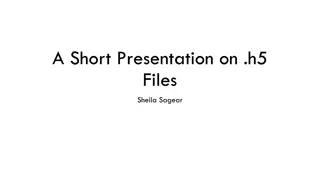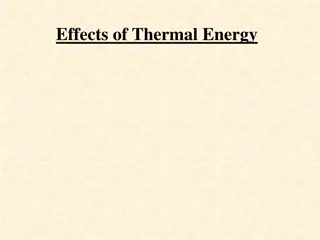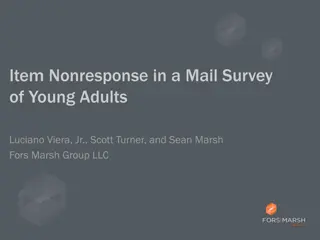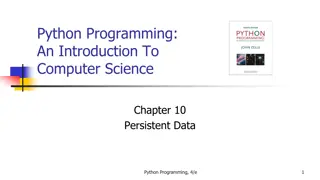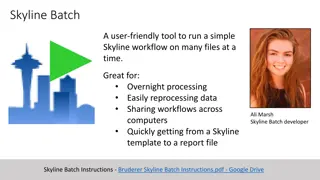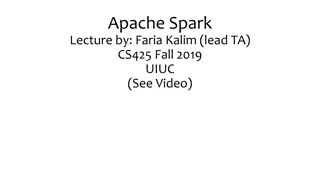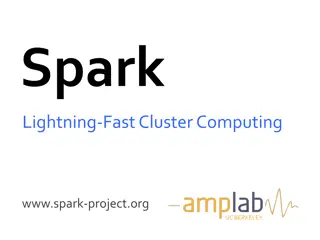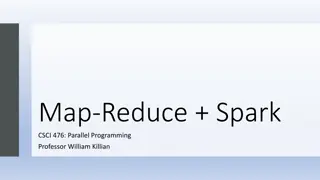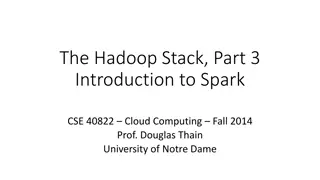Connecting Spark to Files Containing Data - Overview of RDD Model Expansion
Today's lecture explores the evolution of Spark from its inception at Berkeley to its widespread adoption globally. The focus is on the RDD model, which has transitioned into a full programming language resembling SQL, Python, or Scala. Examples of RDD programming at Cornell and in industry settings are showcased, highlighting the versatility and scalability of Spark for big data processing. The intelligence of machine learning in the cloud, data flow redundancy, and real-time performance improvements through fault-tolerant systems are also touched upon.
Download Presentation

Please find below an Image/Link to download the presentation.
The content on the website is provided AS IS for your information and personal use only. It may not be sold, licensed, or shared on other websites without obtaining consent from the author. Download presentation by click this link. If you encounter any issues during the download, it is possible that the publisher has removed the file from their server.
E N D
Presentation Transcript
CONNECTING SPARK TO FILES CONTAINING DATA Ken Birman CS5412 HTTP://WWW.CS.CORNELL.EDU/COURSES/CS5412/2018SP 1
TODAYS LECTURE BORROWS FROM A SLIDE SET FROM A SPARK USER COMMUNITY MEETING Spark was first introduced at Berkeley as a way to speed up Hadoop using in-memory caching. The RDD objects it supports were really just a representation of the recipe for computing each cacheable object from input sources. Then Spark focused on scheduling, and cache retention policies. But it was quickly adopted and became a world-wide craze HTTP://WWW.CS.CORNELL.EDU/COURSES/CS5412/2018SP 2
RDD MODEL RAPIDLY EXPANDED Today, the RDD model is really a full programming language. RDD coding looks like SQL or Python or Scala, depending on what you are doing Basic idea remains the same, but the coverage of the recipes Spark can compute for you through the RDD objects has greatly expanded. HTTP://WWW.CS.CORNELL.EDU/COURSES/CS5412/2018SP 3
TODAYS LECTURE We will start by looking at some examples of RDD programming done at Cornell by Theo when he was doing experiments on the Freeze Frame File System. Then we ll see an open-source slides set a class on RDDs taught by the DataBricks company, in Asia at a big data conference. HTTP://WWW.CS.CORNELL.EDU/COURSES/CS5412/2018SP 4
RDD EXAMPLE Theo Gkountouvas FROM EATON ARPA-E RESEARCH
The intelligence lives in the cloud: machine learning that watches the real-time data stream in and reacts. GRIDCLOUD: MILE HIGH PERSPECTIVE The external infrastructure is mostly dumb sensors and actuators 6
DATA FLOW: REDUNDANT Data collectors (k per sensor, to tolerate k-1 crash faults) RDDs (one per sensor) Smart sensor SPARK data analytics parallel processing framework File in FFFS K TCP links FFFS files (one per sensor) REDUNDANCY FOR FAULT-TOLERANCE AND TO IMPROVE REAL-TIME PERFORMANCE UP TO THE STAGE WHERE THE FILES ARE STORED. THEN FFFS RELIABILITY TAKES OVER. HTTP://WWW.CS.CORNELL.EDU/COURSES/CS5412/2018SP 7
EATON PROJECT Receive data every minute from many different homes. Each home has a central sensor that is responsible for aggregating monitoring information as well as controlling several electrical devices. Our goal for now is to aggregate the monitored consumptions in KVolts as well as keep track of missing (or received information). We assume that the data is already stored in FFFS and we have to write Python code for Spark to perform this analysis.
Initial RDD CODE curTs = long(time.time()) Get current time curTS in seconds. Spark Context sc maintains information about spark instances, spark configuration as well as location of data in FFFS instances (collocation of computation in the same physical node as the stored data). Fetch all recent files generated at some time before curTS. initialRDD = sc.textFile("fffs://10.0.0.10:9000/home/theo/data/sensor[0- 9]*.dat@u" + str(curTs)) deserializedRDD = initialRDD.map(deserialize) processedRDD = deserializedRDD.map(lambda x: (0, 0.0, 0.0, 0.0) if x[1] <= curTs - 60 else (1, x[2], x[3], x[4])) filteredRDD = processedRDD.filter(lambda x: x[0] == 1) res = filteredRDD.reduce(lambda x, y: (x[0]+y[0], x[1]+y[1], x[2]+y[2], x[3]+y[3])) print res
Initial RDD RDD CODE map curTs = long(time.time()) Deserialized RDD initialRDD = sc.textFile("fffs://10.0.0.10:9000/home/theo/data/sensor[0- 9]*.dat@u" + str(curTs)) deserializedRDD = initialRDD.map(deserialize) Deserialize raw packets. Format of data: [(SensorID, TS, WHCons, ACCons, EVCons)] processedRDD = deserializedRDD.map(lambda x: (0, 0.0, 0.0, 0.0) if x[1] <= curTs - 60 else (1, x[2], x[3], x[4])) filteredRDD = processedRDD.filter(lambda x: x[0] == 1) res = filteredRDD.reduce(lambda x, y: (x[0]+y[0], x[1]+y[1], x[2]+y[2], x[3]+y[3])) print res
Initial RDD RDD CODE map curTs = long(time.time()) Deserialized RDD initialRDD = sc.textFile("fffs://10.0.0.10:9000/home/theo/data/sensor[0- 9]*.dat@u" + str(curTs)) map deserializedRDD = initialRDD.map(deserialize) Processed RDD processedRDD = deserializedRDD.map(lambda x: (0, 0.0, 0.0, 0.0) if x[1] <= curTs - 60 else (1, x[2], x[3], x[4])) Keep only relevant information. Missing packets are encoded as (0, 0.0, 0.0, 0.0) Packets are encoded as (1, WHCons, ACCons, EVCons) filteredRDD = processedRDD.filter(lambda x: x[0] == 1) res = filteredRDD.reduce(lambda x, y: (x[0]+y[0], x[1]+y[1], x[2]+y[2], x[3]+y[3])) print res
Initial RDD RDD CODE map curTs = long(time.time()) Deserialized RDD initialRDD = sc.textFile("fffs://10.0.0.10:9000/home/theo/data/sensor[0- 9]*.dat@u" + str(curTs)) map deserializedRDD = initialRDD.map(deserialize) Processed RDD processedRDD = deserializedRDD.map(lambda x: (0, 0.0, 0.0, 0.0) if x[1] <= curTs - 60 else (1, x[2], x[3], x[4])) filter filteredRDD = processedRDD.filter(lambda x: x[0] == 1) Filtered RDD res = filteredRDD.reduce(lambda x, y: (x[0]+y[0], x[1]+y[1], x[2]+y[2], x[3]+y[3])) Filter out missing packets. Not needed. Erase for efficiency (just an example). print res
Initial RDD RDD CODE map curTs = long(time.time()) Deserialized RDD initialRDD = sc.textFile("fffs://10.0.0.10:9000/home/theo/data/sensor[0- 9]*.dat@u" + str(curTs)) map deserializedRDD = initialRDD.map(deserialize) Processed RDD processedRDD = deserializedRDD.map(lambda x: (0, 0.0, 0.0, 0.0) if x[1] <= curTs - 60 else (1, x[2], x[3], x[4])) filter filteredRDD = processedRDD.filter(lambda x: x[0] == 1) Filtered RDD res = filteredRDD.reduce(lambda x, y: (x[0]+y[0], x[1]+y[1], x[2]+y[2], x[3]+y[3])) reduce print res (Number of Packets, Total WHCons, Total ACCons, Total EVCons)
OPTIMIZATIONS Repeating (Real-Time Calculation) Set curTS to curTS + 60 (next minute) Sleep until curTS Repeat again Distribute Load Manually Use initialRDD = sc.parellelize(initialRDD) for manually creating partitions (executors dynamically handle them). You can also set the number of partitions manually.
DISCUSSION It is fairly easy to link the Spark RDD model to real sensor data in FFFS, and to do simple operations on it, like this check for missing data. A significant application could be custom coded at multiple layers: the sensor can be configured (smart sensor), the data collection layer can filter or transform data (smart memory), the RDD can transform data (as shown), and the Spark analytics we run on the RDD can do it too! As a developer, you would favor the option that is easiest to code for your specific use case. HTTP://WWW.CS.CORNELL.EDU/COURSES/CS5412/2018SP 15
DEEPER DIVE ON RDD CODING RDD Basics Creating RDDs RDD Operations Passing Functions to Spark Common Transformations and Actions Persistence (Caching)
RDD BASICS Each RDD is split into multiple partitions, which may be computed on different nodes of the cluster. RDDs can contain any type of Python, Java or Scala objects, including user-defined classes. Users create RDDs in two ways by loading an external dataset by distributing a collection of objects
RDD BASICS Loading a text file as an RDD of strings using SparkContext.textFile() Creating an RDD of strings with textFile() in Python >>> lines = sc.textFile("README.md") RDDs offer two types of operations: transformations and actions Transformations construct a new RDD from a previous one >>> pythonLines = lines.filter(lambda line: "Python" in line) Actions, compute a result based on an RDD >>> pythonLines.first()
RDD BASICS Spark only computes them in a lazy fashion, the first time they are used in an action lines = sc.textFile(...) once Spark sees the whole chain of transformations, it can compute just the data needed for its result first() action, Spark only scans the file until it finds the first matching line >>> pythonLines.first()
RDD BASICS Use persist to load a subset of your data into memory and query it repeatedly >>> pythonLines.persist(StorageLevel.MEMORY_ONLY_SER) >>> pythonLines.count() >>> pythonLines.first()
RDD BASICS A Spark program and shell session works as follows: Create some input RDDs from external data. Transform them to define new RDDs using transformations like filter(). Ask Spark to persist() any intermediate RDDs that will need to be reused. Launch actions such as count() and first() to kick off a parallel computation, which is then optimized and executed by Spark.
CREATING RDD Two ways to create RDDs: loading an external dataset and parallelizing a collection in your driver program. One way to create RDDs is to take an existing in-memory collection and pass it to SparkContext s parallelize method Python parallelize example lines = sc.parallelize(["pandas", "i like pandas"]) Scala parallelize example val lines = sc.parallelize(List("pandas", "i like pandas")) Java parallelize example JavaRDD<String> lines = sc.parallelize(Arrays.asList("pandas", "i like pandas"));
CREATING RDD A second way to create RDDs is to load data in external storage Python textFile example lines = sc.textFile("/path/to/README.md") Scala textFile example val lines = sc.textFile("/path/to/README.md") Java textFile example JavaRDD<String> lines = sc.textFile("/path/to/README.md");
RDD OPERATIONS RDDs support two types of operations, transformations and actions. Transformations are operations on RDDs that return a new RDD, such as map and filter Actions are operations that return a result back to the driver program or write it to storage, and kick off a computation such as count and first Spark treats transformations and actions very differently, so understanding which type of operation you are performing will be important. how to check the type? transformations return RDDs whereas actions return some other data type.
RDD OPERATIONS: TRANSFORMATIONS Transformations are operations on RDDs that return a new RDD transformed RDDs are computed lazily, only when you use them in an action element-wise (not for all cases) Question: we have a log file, log.txt, with a number of messages, and we want to select only the error messages?
RDD OPERATIONS TRANSFORMATION EXAMPLES Python filter example inputRDD = sc.textFile("log.txt") errorsRDD = inputRDD.filter(lambda x: "error" in x) Scala filter example val inputRDD = sc.textFile("log.txt ) val errorsRDD = inputRDD.filter(line => line.contains("error")) Java filter example JavaRDD<String> inputRDD = sc.textFile("log.txt"); JavaRDD<String> errorsRDD = inputRDD.filter( new Function<String, Boolean>() { public Boolean call(String x) { return x.contains("error"); } }); Note that the filter operation does not mutate the existing inputRDD. Instead, it returns a pointer to an entirely new RDD.
RDD OPERATIONS TRANSFORMATIONS union is a bit different than filter, in that it operates on two RDDs instead of one Python union example errorsRDD = inputRDD.filter(lambda x: "error" in x) warningsRDD = inputRDD.filter(lambda x: "warning" in x) badLinesRDD = errorsRDD.union(warningsRDD) lineage graph: Spark keeps track of the set of dependencies between different RDDs
RDD OPERATIONS ACTIONS ACTION EXAMPLES Do something with our dataset They are the operations that return a final value to the driver program or write data to an external storage system Python error count example using actions print "Input had " + badLinesRDD.count() + " concerning lines" print "Here are 10 examples:" for line in badLinesRDD.take(10): print line take() to retrieve a small number of elements in the RDD at the driver program collect() function to retrieve the entire RDD (shouldn t be used on large datasets it s common to write data out to a distributed storage systems such as HDFS or Amazon S3
RDD OPERATIONS LAZY EVALUATION Transformations on RDDs are lazily evaluated, meaning that Spark will not begin to execute until it sees an action Call a transformation on an RDD, the operation is not immediately performed Internally records meta-data to indicate this operation has been requested In Spark, there is no substantial benefit to writing a single complex map instead of chaining together many simple operations http://en.wikibooks.org/wiki/Haskell/Laziness
PASSING FUNCTIONS TO SPARK PYTHON Three options for passing functions into Spark: pass in lambda expressions, pass in top-level functions, or locally defined functions Passing a lambda in Python word = rdd.filter(lambda s: "error" in s) Passing a top-level Python function def containsError(s): return "error" in s word = rdd.filter(containsError)
PASSING FUNCTIONS TO SPARK PYTHON Passing a function with field references (don t do this!) Python function passing without field references class SearchFunctions(object): class WordFunctions(object): ... def getMatchesNoReference(self, rdd): # Safe: extract only the field we need into a local variable query = self.query return rdd.filter(lambda x: query in x) def __init__(self, query): self.query = query def isMatch(self, s): return query in s def getMatchesFunctionReference(self, rdd): # Problem: references all of "self" in "self.isMatch" return rdd.filter(self.isMatch) def getMatchesMemberReference(self, rdd): # Problem: references all of "self" in "self.query" return rdd.filter(lambda x: self.query in x)
PASSING FUNCTIONS TO SPARK SCALAIn Scala, we can pass in functions defined inline or references to methods or static functions as we do for Scala s other functional APIs Scala function passing class SearchFunctions(val query: String) { def isMatch(s: String): Boolean = { s.contains(query) } def getMatchesFunctionReference(rdd: RDD[String]): RDD[String] = { // Problem: "isMatch" means "this.isMatch", so we pass all of "this" rdd.map(isMatch) } def getMatchesFieldReference(rdd: RDD[String]): RDD[String] = { // Problem: "query" means "this.query", so we pass all of "this" rdd.map(x => x.split(query)) } def getMatchesNoReference(rdd: RDD[String]): RDD[String] = { // Safe: extract just the field we need into a local variable val query_ = this.query rdd.map(x => x.split(query_)) } }
PASSING FUNCTIONS TO SPARK JAVA In Java, functions are specified as objects that implement one of Spark s function inter faces from the org.apache.spark.api.java.function package. Standard Java function interfaces: Function name method to implement Usage Function<T, R> R call(T) Take in one input and return one output, for use with things like map and filter. Function2<T1, T2, R> R call(T1,T2) Take in two inputs and return one output, for use with things like aggregate or fold. FlatMapFunction<T, R> Iterable<R> call(T) Take in one input and return zero or more outputs, for use with things like flatMap.
PASSING FUNCTIONS TO SPARK JAVA We can either define our function classes in-line as anonymous inner classes, or make a named class: Java function passing with anonymous inner class RDD<String> errors = lines.filter(new Function<String, Boolean>() { public Boolean call(String x) { return s.contains("error"); } }); Java function passing with named class class ContainsError implements Function<String, Boolean>() { public Boolean call(String x) { return x.contains("error"); } } RDD<String> errors = lines.filter(new ContainsError());
PASSING FUNCTIONS TO SPARK JAVA Top-level named functions are often cleaner for organizing large programs Java function class with parameters class Contains implements Function<String, Boolean>() { private String query; public Contains(String query) { this.query = query; } public Boolean call(String x) { return x.contains(query); } } RDD<String> errors = lines.filter(new Contains("error")); Java function passing with lambda expression in Java 8 RDD<String> errors = lines.filter(s -> s.contains("error"));
BASIC RDDS ELEMENT-WISE TRANSFORMATIONS The two most common transformations you will likely be performing on basic RDDs are map, and filter map transformation: takes in a function and applies it to each element in the RDD with the result of the function being the new value of each element in the resulting RDD filter transformation take in a function and returns an RDD which only has elements that pass the filter function
BASIC RDDS ELEMENT-WISE TRANSFORMATIONS Python squaring the value in an RDD nums = sc.parallelize([1, 2, 3, 4]) squared = nums.map(lambda x: x * x).collect() for num in squared: print "%i " % (num) Scala squaring the values in an RDD val input = sc.parallelize(List(1, 2, 3, 4)) val result = input.map(x => x * x) println(result.collect().mkString(",")) Java squaring the values in an RDD JavaRDD<Integer> rdd = sc.parallelize(Arrays.asList(1, 2, 3, 4)); JavaRDD<Integer> result = rdd.map(new Function<Integer, Integer>() { public Integer call(Integer x) { return x*x; } }); System.out.println(StringUtils.join(result.collect(), ","));
BASIC RDDS ELEMENT-WISE TRANSFORMATIONS Python flatMap example, splitting lines into words lines = sc.parallelize(["hello world", "hi"]) words = lines.flatMap(lambda line: line.split(" ")) words.first() # returns "hello Scala flatMap example, splitting lines into multiple words val lines = sc.parallelize(List("hello world", "hi")) val words = lines.flatMap(line => line.split(" ")) words.first() // returns "hello Java flatMap example, splitting lines into multiple words JavaRDD<String> lines = sc.parallelize(Arrays.asList("hello world", "hi")); JavaRDD<String> words = lines.flatMap(new FlatMapFunction<String, String>() { public Iterable<String> call(String line) { return Arrays.asList(line.split(" ")); } }); words.first(); // returns "hello
BASIC RDDS PSEUDO SET OPERATIONS RDDs support many of the operations of mathematical sets, such as union and inter section, even when the RDDs themselves are not properly sets. Note that distinct() is expensive
BASIC RDDS PSEUDO SET OPERATIONS Compute a Cartesian product between two RDDs The cartesian(other) transformation results in possible pairs of (a, b) where a is in the source RDD and b is in the other RDD Cartesian product can be useful when we wish to consider the similarity between all possible pairs such as computing every users expected inter ests in each offer take the Cartesian product of an RDD with itself, which can be useful for tasks like computing user similarity
BASIC RDDS PSEUDO SET OPERATIONS Basic RDD transformations on an RDD containing {1, 2, 3, 3} Function Name Example Result map rdd.map(x => x + 1) {2, 3, 4, 4} flatMap rdd.flatMap(x => x.to(3)) {1, 2, 3, 2, 3, 3, 3} filter rdd.filter(x => x != 1 ) {2, 3, 3} distinct rdd.distinct() {1, 2, 3} sample(withReplacement, fraction,[seed]) rdd.sample(false, 0.5) non- deterministi c
BASIC RDDS PSEUDO SET OPERATIONS Two-RDD transformations on RDDs containing {1, 2, 3} and {3, 4, 5} Function Name Example Result union rdd.union(other) {1, 2, 3, 3, 4, 5} intersection rdd.intersection(other) {3} substract rdd.subtract(other) {1, 2} cartesian rdd.cartesian(other) {(1, 3), (1, 4), ... (3,5)}
BASIC RDDS ACTIONS The most common action on basic RDDs you will likely use is reduce Reduce takes in a function which operates on two elements of the same type of your RDD and returns a new element of the same type With reduce we can easily sum the elements of our RDD, count the number of elements, and perform other types of aggregations Python reduce example sum = rdd.reduce(lambda x, y: x + y) Scala reduce example val sum = rdd.reduce((x, y) => x + y) Java reduce example Integer sum = rdd.reduce(new Function2<Integer, Integer, Integer>() { public Integer call(Integer x, Integer y) { return x + y;} });
BASIC RDDS ACTIONS With aggregate supply an initial zero value of the type we want to return supply a function to combine the elements from our RDD with the accumulator supply a second function to merge two accumulators, given that each node accumulates its own results locally
BASIC RDDS ACTIONS Python aggregate example sumCount = nums.aggregate((0, 0), (lambda x, y: (x[0] + y, x[1] + 1)), (lambda x, y: (x[0] + y[0], x[1] + y[1])))) return sumCount[0] / float(sumCount[1]) Scala aggregate example val result = input.aggregate((0, 0))( (x, y) => (x._1 + y, x._2 + 1), (x, y) => (x._1 + y._1, x._2 + y._2)) val avg = result._1 / result._2.toDouble http://stackoverflow.com/questions/26761087/explanation-of-the-aggregate-scala-function
take(n) returns n elements from the RDD and attempts to minimize the number of partitions it accesses, so it may represent a biased collection. The takeSample(with Replacement, num, seed) function allows us to take a sample of our data either with or without replacement. BASIC RDDS ACTIONS Java aggregate example Function2<AvgCount, AvgCount, AvgCount> combine = class AvgCount { public AvgCount(int total, int num) { this.total = total; this.num = num; } public int total; public int num; public double avg() { return total / (double) num; } new Function2<AvgCount, AvgCount, AvgCount>() { public AvgCount call(AvgCount a, AvgCount b) { a.total += b.total; a.num += b.num; return a; } }; Function2<AvgCount, Integer, AvgCount> addAndCount = AvgCount initial = new AvgCount(0, 0); AvgCount result = rdd.aggregate(initial, addAndCount, combine); new Function2<AvgCount, Integer, AvgCount>() { public AvgCount call(AvgCount a, Integer x) { a.total += x; a.num += 1; return a; System.out.println(result.avg()); } };
BASIC RDDS BASIC ACTIONS ON AN RDD CONTAINING {1,2,3,3} Function Name Example Result collect() rdd.collect() {1,2,3,3} count() rdd.count() 4 take(num) rdd.take(2) {1,2} top(num) rdd.top(2) {3,3} takeOrdered(num)(ordering) rdd.takeOrdered(2)(myOrdering) {3,3} takeSample(withReplacement, num, [seed]) rdd.takeSample(false,1) non-deterministic reduce(func) rdd.reduce((x,y)=>x+y) 9 fold(zero)(func) rdd.fold(0)((x,y)=>x+y) 9 aggregate(zeroValue)(seqOp,combOp) rdd.aggregate(0,0)({case(x,y)=>(y._1() +x., y._2() + 1)}, {case(x,y) => (y._1()+x._1(), y._2()+x._2())}) (9,4) foreach(func) rdd.foreach(func) nothing
BASIC RDDS CONVERTING BETWEEN RDD TYPES Some functions are only available on certain types of RDDs, such as average on numeric RDDs and join on key-value pair RDDs Scala In Scala the conversion between such RDDs (like from RDD[Double] and RDD[Numer ic] to DoubleRDD) is handled automatically using implicit conversions. Java In Java the conversion between the specialized types of RDDs is a bit more explicit.
BASIC RDDS CONVERTING BETWEEN RDD TYPES Function Name Equivalent Function*<A,B, > Usage DoubleFlatMapFunction<T> Function<T,Iterable<Double>> DoubleRDD from a flatMapToDouble DoubleFunction<T> Function<T,double> DoubleRDD from mapToDouble PairFlatMapFunction<T,K,V> Function<T,Iterable<Tuple2<K,V>>> PairRDD<K,V> from a flatMapToPair PairFunction<T,K,V> Function<T,Tuple2<K,V>> PairRDD<K,v> from a mapToPair Java create DoubleRDD example JavaDoubleRDD result = rdd.mapToDouble( new DoubleFunction<Integer>() { public double call(Integer x) { return (double) x * x; } }); System.out.println(result.average());
PERSISTENCE Sometimes we may wish to use the same RDD multiple times If we do this naively, Spark will recompute the RDD and all of its dependencies each time we call an action on the RDD Scala double execute example val result = input.map(x => x*x) println(result.count()) println(result.collect().mkString(","))







